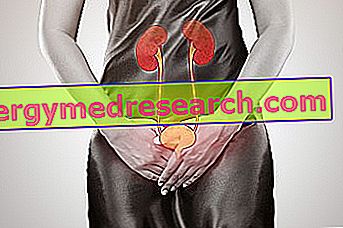Generality
Paracetamol (or acetaminophen) is a drug belonging to the class of analgesic-antipyretics. It is considered a rather safe drug, so that it can be administered - at the appropriate dosages - even to newborns.

Paracetamol - Chemical Structure
Contrary to what many mistakenly think, paracetamol is NOT equipped with anti-inflammatory activity, but has a marked analgesic activity which makes it useful in the treatment of many arthritic and musculoskeletal disorders.
Paracetamol is available in various pharmaceutical formulations suitable for oral, rectal and parenteral administration.
From the chemical point of view, paracetamol is a derivative of para-aminophenol, obtained by the acetylation of the latter.
Examples of medicinal specialties containing Paracetamol
- Actigrip ® (in combination with triprolidine and pseudoephedrine).
- Buscopan compositum ® (in combination with butylscopolamine).
- Codamol ® (in association with codeine).
- Efferalgan ®.
- Panadol ®.
- Tachipirina ®.
- Zerinol ® (in combination with chlorphenamine).
Indications
For what it uses
The use of paracetamol is indicated for the treatment of:
- Temperature;
- Mild to moderate pain of different nature and origin (such as headache, neuralgia, myalgia, joint pain, post-operative pain, toothache, menstrual pain, etc.).
Warnings
In patients with mild to moderate liver disease and in patients already being treated with drugs that may affect liver function, paracetamol should be administered with extreme caution due to liver damage that could result.
Because of the alterations that the drug can cause to the blood and kidneys, paracetamol must be administered with caution also in patients suffering from haemolytic anemia and in patients with a deficiency of the enzyme glucose-6-phosphate dehydrogenase.
Finally, paracetamol should be administered with caution even in the following cases:
- In patients who make excessive use or who abuse alcohol;
- In patients suffering from bulimia or anorexia;
- In patients with cachexia;
- In patients with chronic malnutrition;
- In dehydrated patients;
- In patients with hypovolemia.
If it is necessary to use paracetamol for long periods, it is good to carry out regular checks to monitor liver and kidney function and blood crasis.
Should any type of allergic reaction occur during treatment with paracetamol, treatment with the drug should be immediately suspended and the doctor should be informed immediately.
Interactions
When oral paracetamol is administered concomitantly with drugs capable of reducing the speed of gastric emptying (such as, for example, anticholinergics and opioid analgesics ) a decrease in the bioavailability of the same paracetamol may occur.
Conversely, when the drug is administered concomitantly with drugs that increase the speed of gastric emptying (such as prokinetics ), then there is an increase in the bioavailability of paracetamol.
Concurrent administration of paracetamol orally and cholestyramine (a drug used against high cholesterol) reduces the absorption of paracetamol itself.
Concomitant intake of paracetamol and chloramphenicol (an antibiotic) can cause an increase in the plasma half-life of the latter, with the risk of increasing its toxicity.
The use of paracetamol at rather high doses concomitantly with oral anticoagulants may cause a slight increase in prothrombin time. In these cases, therefore, frequent checks are required.
Paracetamol should be used with caution in patients on chronic treatment with other drugs that can induce hepatic monoxygenases (such as, for example, cimetidine, rifampicin and some antiepileptics ).
The administration of paracetamol could affect some types of laboratory tests performed to determine uric acid and blood glucose levels.
In any case, it is still advisable to inform your doctor if you are taking - or have recently been - any type of medication, including non-prescription medicines and herbal and homeopathic products.
Side effects
Although it is a well tolerated and considered safe drug, even paracetamol can cause several side effects, even if not all patients experience them. This depends on the different sensitivity that each individual has towards the drug.
The main side effects that may occur during treatment with paracetamol are listed below.
Blood and lymphatic system disorders
Paracetamol therapy could cause:
- Piastrinopenia, ie the decrease in the number of platelets in the bloodstream;
- Leukopenia, that is the reduction of the levels of leukocytes in the blood;
- Agranulocytosis, ie a severe decrease in granulocyte levels in the bloodstream;
- Anemia.
Allergic reactions
Paracetamol can trigger allergic reactions in sensitive individuals. These reactions can occur in the form of hives, angioedema, laryngeal edema and anaphylactic shock.
Skin and subcutaneous tissue disorders
Treatment with paracetamol can cause:
- Skin eruptions;
- Erythema multiforme;
- Stevens-Johnson syndrome;
- Toxic epidermal necrolysis.
Hepatobiliary disorders
Paracetamol therapy can alter liver function and promote the onset of hepatitis.
Kidney and urinary tract disorders
Paracetamol-based treatment can cause;
- Acute renal failure;
- Interstitial nephritis;
- Hematuria (ie the presence of blood in the urine);
- Anuria (ie the lack of urine production).
Other side effects
Other side effects that could occur during paracetamol therapy are:
- Gastrointestinal disorders;
- Dizziness;
- Abnormal increase in heart rate (when paracetamol is given intravenously);
- Pain or burning at the injection site (when paracetamol is given intravenously).
Overdose
The risk of overdose exists and is greater in patients suffering from liver disease, in alcoholics, in patients suffering from chronic malnutrition and in patients taking enzyme inducers.
The first symptoms that can appear in case of paracetamol overdose are:
- Nausea;
- He retched;
- Anorexia;
- Epigastric pain;
- Decline of the general conditions.
Paracetamol overdosage can then cause lysis of liver cells which can lead to irreversible hepatic necrosis, with fatal results. Furthermore, there is an increase in plasma levels of liver transaminases, lactic dehydrogenase and bilirubin and a decrease in blood levels of prothrombin.
The antidote for paracetamol overdosage is N-acetylcysteine which must be administered by intravenous infusion. Gastric emptying can also be useful.
In any case, if you suspect a paracetamol overdose, contact your doctor immediately and contact the nearest hospital.
Action mechanism
Paracetamol is a drug with marked analgesic and antipyretic activity, but the exact mechanism by which this drug performs its action has not yet been fully clarified. The most accredited hypothesis is that according to which paracetamol performs its actions through the inhibition of a particular isoform of the cyclooxygenase enzyme expressed above all at central level: COX-3.
Cyclooxygenase is an enzyme of which three different isoforms are known: COX-1, COX-2 and COX-3. The task of these enzymes is to convert arachidonic acid into prostaglandins, prostacyclines and thromboxanes. In particular, prostaglandins mediate pain responses and are implicated in mechanisms that cause body temperature to rise.
Therefore, paracetamol, by inhibiting COX-3 at central level, prevents the synthesis of prostaglandins (in particular prostaglandins E or PGE) responsible for the onset of fever and pain.
Mode of Use - Posology
As mentioned, paracetamol is available in different pharmaceutical formulations suitable for different administration routes.
More in detail, paracetamol is available for:
- Oral administration in the form of tablets, effervescent tablets, orodispersible tablets, effervescent granules, syrup, powder for oral solution and oral drops.
- Administration via the rectum in the form of suppositories.
- Parenteral administration as a solution for intravenous infusion.
During treatment with the drug - to avoid the occurrence of dangerous side effects, especially in the liver and kidney - it is essential never to exceed the recommended paracetamol doses and it is necessary to scrupulously adhere to the indications provided by the doctor, both as regards the amount of drug to be taken, both as regards the frequency of administration and the duration of the same treatment.
Following are some indications on the doses of paracetamol usually used in therapy.
In any case, to know the exact dosage of each pharmaceutical formulation, see the illustrative leaflets of the individual medicinal products.
Oral and rectal administration
When paracetamol is administered orally or rectally, the dose usually used in adults is 500-1000 mg of drug per day, to be taken 3-4 times a day, with intervals of at least four hours between one administration and the next. 'else. The amount of drug to be taken and the frequency of administration vary according to the severity of the symptoms and the clinical conditions of each individual patient.
The dose usually used in children ranges from 120 to 500 mg of paracetamol, to be taken at most four times a day. In infancy, on the other hand, the dose of paracetamol usually administered is 40-120 mg, to be taken at most four times a day.
The amount of paracetamol to be administered to children and in early infancy varies according to the body weight of each child. In any case, the maximum recommended daily allowances should never be exceeded.
Intravenous administration
The amount of paracetamol to be administered intravenously depends on the patient's body weight.
In patients weighing less than 10 kg, the dose of paracetamol usually used is 7.5 mg / kg, to be taken at most four times a day without exceeding the maximum daily dose of 30 mg / kg of body weight.
In patients weighing between 10 and 33 kg, the usual drug dose is 15 mg / kg, to be administered at most four times a day. In any case, the maximum daily dose of 2 grams of drug should never be exceeded.
In patients weighing between 33 and 50 kg, the usual dose of medication is 15 mg / kg of body weight, to be administered at most four times a day without exceeding the maximum dose of 3 grams of paracetamol per day.
In patients weighing more than 50 kg, instead, the dose normally used is 1 gram of paracetamol, to be administered at most four times a day without exceeding the maximum dose of 3-4 grams of drug per day.
Pregnancy and breastfeeding
Paracetamol can be used during pregnancy, but only after asking the doctor's advice and only after the latter has made an assessment of the relationship between the expected benefits for the mother and the potential risks that could be present for the fetus.
Paracetamol is excreted in small parts in breast milk and cases of rash have been reported in infants whose mothers took paracetamol. However, the drug can still be taken during breastfeeding, but with caution and only after asking the doctor's advice.
Contraindications
The use of paracetamol is contraindicated in the following cases:
- In patients with known hypersensitivity to paracetamol itself;
- In patients with severe hemolytic anemia;
- In patients suffering from severe liver disease.



